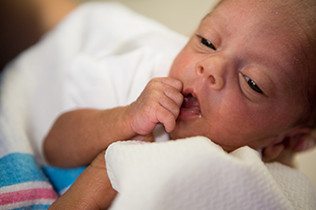Definisi
Gastroskisis adalah kelainan bawaan yang ditandai dengan kecacatan dinding perut. Akibatnya, usus bayi ditemukan di luar tubuh bayi dan keluar melalui lubang pada perut. Lubang ini dapat berukuran kecil atau besar, dan organ selain usus seperti lambung dan hati dapat pula ditemukan di luar tubuh bayi. Kondisi ini terjadi pada 1 bayi setiap 4.000 kelahiran hidup.
Penyebab
Kegagalan penutupan dinding perut dapat dibagi menjadi dua: omfalokel dan gastroskisis. Berbeda dengan gastroskisis, pada omfalokel, usus yang keluar perut masih dilapisi oleh lapisan dari tali pusat dan lapisan peritoneum (jaringan yang melapisi rongga perut). Sementara itu, pada gastroskisis, usus yang berada di luar tubuh sama sekali tidak dilapisi oleh apapun.
Penyebab gastroskisis tidak sepenuhnya diketahui. Proses terjadinya gastroskisis dimulai akibat kegagalan pembentukan dan perkembangan dinding tubuh bagian depan pada fase embrio. Hal ini kemudian menyebabkan dinding perut lemah, sehingga ketika usus bertumbuh, dinding tersebut berlubang dan usus tumbuh ke luar tubuh. Studi pada tikus menunjukkan adanya faktor kurangnya asam folat, oksigen, dan penggunaan produk salisilat sebagai penyebab gangguan pembentukan dinding perut. Namun, hasil ini belum tentu sama dengan manusia.
Faktor Risiko
Terdapat beberapa faktor risiko terjadinya gastroskisis, diantaranya:
- Bayi dengan ibu yang hamil pada usia di bawah 20 tahun
- Ibu perokok aktif dan/atau mengonsumsi alkohol secara berlebihan
- Gastroskisis lebih banyak ditemukan pada bayi laki-laki dibandingkan dengan bayi perempuan, dengan perbandingan 1,5:1
Gejala
Gastroskisis dapat dikenali secara kasat mata. Biasanya, ditemukan bagian usus yang berada di luar tubuh serta terdapat lubang di perut sebagai jalur keluar bagian usus tersebut. Biasanya, lubang tersebut memiliki diameter kurang lebih 5 cm dan terletak di sebelah kanan tali pusat. Usus dapat terlihat normal dengan lekukannya, namun dapat pula membesar akibat pembengkakan. Pembengkakan ini dapat mempersulit pencarian kelainan lainnya pada usus, misalnya adanya sumbatan pada bagian usus lainnya.
Diagnosis
Diagnosis gastroskisis dapat dilakukan pada saat kehamilan berusia 20 minggu atau sekitar 5 bulan. Kelainan ini dapat dilihat dengan bantuan ultrasonografi (USG). Pada USG, gastroskisis akan tampak seperti adanya lubang pada sisi kanan tali pusat dan adanya lengkungan usus yang mengambang di luar tubuh janin. Usus yang terpapar cairan ketuban dapat menebal dan melebar. Janin yang mengalami gastroskisis dapat memiliki berat badan lahir rendah. Tidak hanya itu, pada saat kehamilan, dapat terjadi kelahiran spontan prematur atau bahkan kematian janin di dalam rahim. Pemeriksaan USG pada saat kehamilan akan dilakukan secara rutin untuk mengetahui kemungkinan usus akan bertahan hidup.
Pemeriksaaan laboratorium dapat pula dilakukan. Pada gastroskisis, kadar alfa-fetoprotein (AFP) akan meningkat.
Setelah lahir, USG dapat pula dilakukan untuk mengetahui adanya kelainan usus pada usus yang berada di luar perut. Hasil pemeriksaan USG ini dapat menemukan adanya sumbatan di antara usus tersebut. Selain itu, pengecekan terkait peradangan, kemampuan lewatnya mekonium (kotoran janin) pada usus, serta sifat cairan usus dapat menentukan apakah dinding perut dapat ditutup langsung atau harus menggunakan “silo”. Silo berfungsi untuk melapisi usus selama peradangan masih terjadi. Setelah usus membaik, tata laksana gastroskisis dapat dilakukan.
Pemeriksaan organ tubuh lainnya seperti jantung dan paru dalam USG kehamilan juga dapat dilakukan untuk mencari adanya kelainan selain gastroskisis yang terjadi bersamaan. Pemeriksaan kromosom dapat pula dilakukan untuk mencari adanya kelainan genetik yang menjadi penyebab gastroskisis.
Tata Laksana
Tata laksana gastroskisis dibagi menjadi empat fase:
- Kehamilan. Selama kehamilan, janin akan diperiksa secara berkala dengan USG karena janin dengan gastroskisis biasanya memiliki berat badan lahir rendah. Pemeriksaan-pemeriksaan lainnya dapat dilakukan untuk memastikan bahwa janin hidup serta bagian usus di luar perut dapat diselamatkan.
- Persalinan. Persalinan dapat dilakukan secara normal. Persalinan sangat tergantung dari usia kehamilan yang terkait dengan pematangan paru, temuan USG, dan hasil tes janin. Sebaiknya, jika janin sudah diketahui memiliki gastroskisis, persalinan dilakukan di rumah sakit rujukan, karena kelahiran bayi dengan kondisi ini seringkali memerlukan kolaborasi antarbidang ilmu kedokteran. Dengan adanya kondisi ini, ada kemungkinan bahwa bayi akan lahir kurang bulan.
- Tata laksana awal. Setelah bayi dilahirkan, tata laksana dilanjutkan di ruang perawatan. Penguapan air pada usus di luar tubuh sekitar 2,5 kali lebih cepat daripada penguapan dari bagian tubuh normal lainnya, sehingga usus yang berada di luar tubuh akan ditampung dengan silo. Silo tidak hanya melindungi usus, melainkan juga dapat digunakan untuk memantau aliran darah dan kecukupan oksigen pada usus. Selang makan juga dapat dimasukkan untuk menurunkan tekanan pada lambung. Bayi juga akan dipasangkan infus untuk memasukkan antibiotik pencegah infeksi dan memberikan cairan sesuai kebutuhan sehari-hari. Stabilitas kondisi bayi juga akan dipantau ketat dan dijaga.
- Tata laksana pembedahan. Tata laksana pembedahan dapat dipertimbangkan. Tujuan utama pembedahan adalah mengembalikan usus ke dalam tubuh, sambil meminimalkan cedera usus atau peningkatan tekanan dalam perut yang berlebihan. Terdapat dua pembedahan yang dapat menjadi pilihan pada kondisi ini: pertama adalah perbaikan primer, kedua adalah penutupan yang ditunda. Intinya, kedua prosedur ini akan menurunkan peradangan pada usus yang terpapar cairan ketuban serta memasukkannya ke dalam perut. Pembedahan ini dilakukan sambil melakukan pengecekan pada usus yang akan dimasukkan, karena apabila ada sumbatan atau lubang pada usus tersebut, tata laksana yang sesuai dapat segera dilakukan. Biasanya, usus dapat mulai dimasukkan ke dalam perut dalam 1 minggu. Namun, kelainan fungsi usus baru dapat pulih sekitar 4-6 minggu kemudian, sehingga menurunkan kemungkinan bayi untuk dapat mencerna ASI dengan baik selama periode tersebut.
Komplikasi
Komplikasi gastroskisis sangat beragam. Janin yang mengalami gastroskisis memiliki risiko 28% dilahirkan kurang bulan. Selain itu, karena usus belum dapat bekerja dengan baik, nutrisi akan diberikan lewat infus, sehingga berisiko infeksi tinggi. Peradangan pada usus dan infeksi bekas luka penutupan gastroskisis juga dapat terjadi. Selain itu, bayi dengan gastroskisis juga biasanya memiliki masalah usus lainnya seperti sumbatan, perlubangan, serta terjadinya peradangan usus. Komplikasi-komplikasi ini dapat menjadi pertimbangan untuk melakukan cangkok usus untuk bayi.
Pencegahan
Pencegahan gastroskisis dapat dilakukan dengan perencanaan kehamilan dengan matang. Sebaiknya kehamilan direncanakan pada saat usia wanita di atas 20 tahun, karena risikonya terhadap berbagai kelainan (seperti gastroskisis) jauh lebih kecil. Selain itu, ibu sebaiknya tidak merokok dan minum alkohol berlebih saat merencanakan kehamilan.
Kapan Harus ke Dokter?
Jika bayi Anda tampak memiliki usus yang keluar dari tubuh, baik dengan pelapis maupun tidak, segeralah bawa ke dokter. Gastroskisis sangat meningkatkan risiko infeksi pada usus yang dapat menyebabkan kematian. Perujukan ke rumah sakit rujukan biasanya akan dilakukan sesegera mungkin apabila gastroskisis diketahui setelah lahir. Apabila gastroskisis telah diketahui sebelum bayi lahir, perencanaan persalinan dapat dilakukan di tempat-tempat dengan fasilitas yang lebih lengkap.
Mau tahu informasi seputar penyakit lainnya? Cek di sini, ya!
- dr Nadia Opmalina
Facts about Gastroschisis | CDC. (2020). Retrieved 18, 2022, from https://www.cdc.gov/ncbddd/birthdefects/gastroschisis.html
Glasser, J. (2019). Pediatric Omphalocele and Gastroschisis (Abdominal Wall Defects): Background, Pathophysiology, and Etiology. Retrieved 18, 2022, from https://emedicine.medscape.com/article/975583-overview
Rentea, R., & Gupta, V. (2021). Gastroschisis. Retrieved January 18, 2022, from https://www.ncbi.nlm.nih.gov/books/NBK557894/












